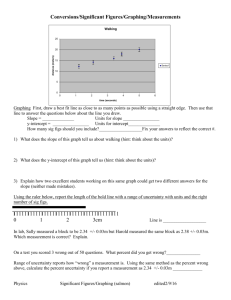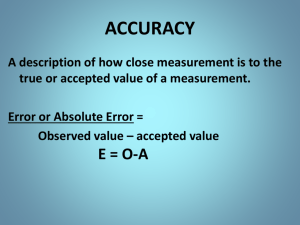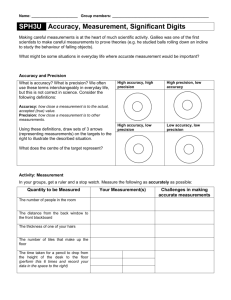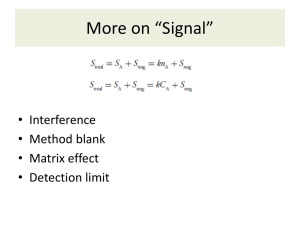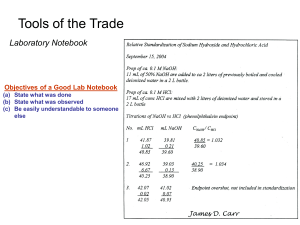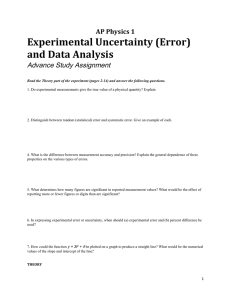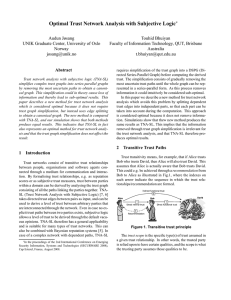PHYSICS
advertisement
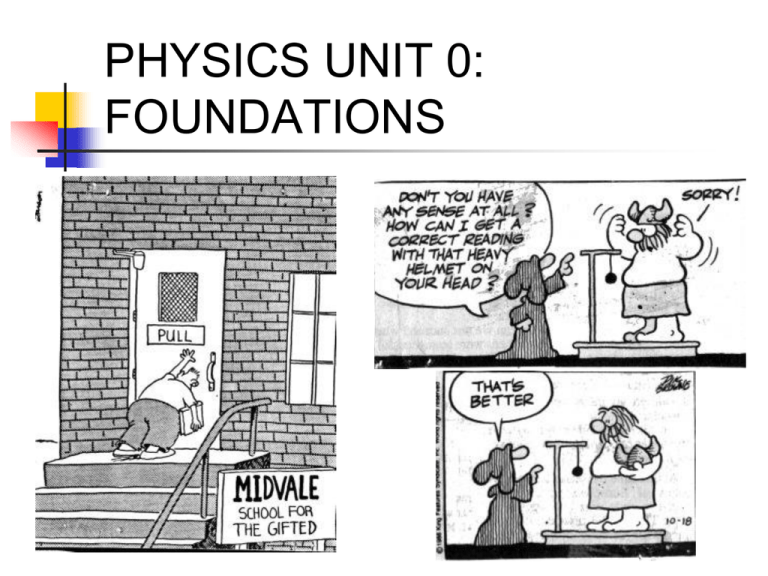
PHYSICS UNIT 0: FOUNDATIONS MEASUREMENT Units of Measure - Metric System (SI) Fundamental Units: defined by scientists Dimension length mass time current temperature Unit meter kilogram second ampere Kelvin Symbol m kg s A K Derived Units: combinations of fundamental units 2 ex: area measured in m , density measured in g/cm3 Measurement Important Ranges of Magnitudes to remember Distances – size of a nucleus(10^-15 m) to size of the universe (10^25 m) Masses – mass of an electron(10^-30 kg) to mass of the universe (10^53 kg) Times – time for light to pass a nucleus (10^-23 s) to age of the universe (10^18 s) So what are the order of magnitude differences? MEASUREMENT prefixes: for larger or smaller quantities Prefix Giga mega kilo deci centi milli micro nano Symbol G M k d c m m n Value Example 109 30 Gb = 30,000,000,000 b 106 2.1 Mm = 2,100,000 m 103 3.5 kg = 3500 g 10–1 8.7 dL = 0.87 L 10–2 5.9 cs = 0.059 s 10–3 7.2 mmol = 0.0072 mol 10–6 4.4 mm = 0.0000044 m 10–9 9.0 ng = 0.000000009 g MEASUREMENT conversions from one prefix to another: mega kilo none deci centi milli 1000 1000 10 larger units divide 10 10 micro 1000 1000 smaller units multiply nano MEASUREMENT conversion factors - multipliers that change units without changing equation’s overall value (factors have a value of 1) ex: 1 in = 2.54 cm factors: 2.54 cm 1 in 1 in 2.54 cm set up so units cancel ex: find the kilometers in 1 mile 1 mi 5280 ft 1 mi 12 in 2.54 cm 1 in 1 ft 1m 100 cm 1 km 1000 m 1.60 km MATHEMATICS Scientific Notation: shorthand for large & small numbers form: 0.00 × 10 0 (number ≥ 1 & < 10 × power of 10) ex: 450,000,000 = 4.5 × 100,000,000 = 4.5 × 108 –6 0.0000036 = 3.6 × 0.000001 = 3.6 × 10 MATHEMATICS Scientific Calculators 4.5 × 108 is entered 4 and may appear as 4.5 3.6 × 10–6 is entered 3 and may appear as 3.6 5 . 08 or . 6 -06 or EE 8 4.5 08 EE +/- 3.6 -06 some calculators use EXP instead of EE 6 UNCERTAINTY Significant Figures shorthand way of showing precision & uncertainty number of sig. fig's = # of digits BUT don't count beginning zeroes AND don't count ending zeroes unless there is a decimal. 234.15 14.080 560,000 0.00282 5.6 × 105 UNCERTAINTY Significant Figures calculations cannot be more exact than measurements: a. round off to least number of sig. fig's ex:(1.05)(39.04)(251,000)(0.0044)=45271.5 65 round off to 2 sig. fig's = 45,000 b. round off once, at the end of all calculations c. when in doubt, round to 3 sig. fig's PHYSICS UNIT 0: FOUNDATIONS The 2 Major Types of Error in Experimental Physics Systematic Error- Errors inherent in the system of data taking. (Can not be cancelled with lots of data) Example – using an uncalibrated scale. Random Error- are inherently unpredictable. (Can be cancelled out with lots of data) Example – stopping a stop watch too early sometimes and too late other times. Systematic Error There are 3 major types of systematic error human error: mistakes in reading & recording make repeat measurements (Do not include in lab write up, instead fix human problem). method error: mistakes in measurement methods choose the best method & use it consistently. instrument error: mistakes due to damaged instruments check instrument calibration, use carefully. UNCERTAINTY Accuracy- the degree of closeness of experimental result with theoretical result. (Low systematic error) Assessing accuracy: percent error (if you know what the measurement should have been by other methods) |O – A| |observed – accepted| % Error = A ×100= ×100 accepted UNCERTAINTY Precision: limitations of a measuring instrument (Sensitivity) the more digits you can read, the more precision (less uncertainty) A precise measuring device will take repeated measurements that are close to each other. 11 11 0.60.6 ± 0.1 ± 0.1 0.63 0.63 ±± 0.01 0.01 (less (less certain certain - 1- 1digit) digit) (more (more certain certain --22digits) digits) GRAPHING choose & show scale on each axis - fit all data label each axis: measured quantity & units title graph dependent variable: y, independent variable:x Uncertainty in data should be included on graph Include the equation that best fits the data Distance Fallen vs. Time 2 y = 5x Distance Fallen (m) purpose: finding patterns & relationships drawing graphs: 500 400 300 200 100 0 0 2 4 6 Time (s) 8 10 GRAPHING graph interpretation: linear relationship: as x increases, y increases (y x) y = mx+b m: slope, b:y-intercept Said “The distance traveled by a car moving at constant speed is directly proportional to the time travelled.”. GRAPHING graph interpretation: quadratic relationship: as x increases, y increases (y x2) y = kx2 k: appropriate constant Said “The bacteria population grew exponentially with time.” GRAPHING graph interpretation: inverse relationship: as x increases, y decreases (y 1/x) y = k/x k: appropriate constant Said “For any given constant force acting on an object there is an inverse relationship between and object’s mass and it’s acceleration” UNIT 0 QUIZ PREVIEW Concepts Covered: metric system: units, prefixes & conversions accuracy, precision & significant figures math skills – algebra, scientific notation, estimation, types of graphs. What’s On The Quiz: __ multiple choice/matching __ problems Equations for Propagating Error Sum ( A A) ( B B) ( A B) (A B) Difference ( A A) ( B B) ( A B) (A B) Product A100% B100% ( A A) ( B B) ( A B) A B Quotient A100% B100% ( A A) ( B B) ( A B) A B
